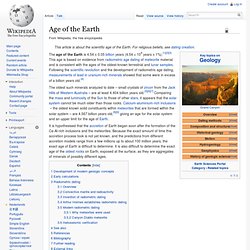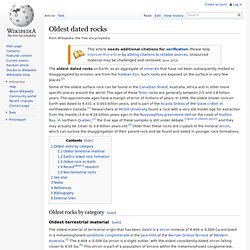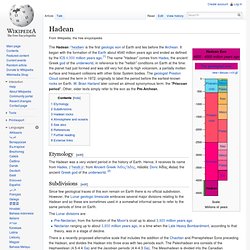

Timeline of natural history. Age of the Earth. The oldest such minerals analyzed to date – small crystals of zircon from the Jack Hills of Western Australia – are at least 4.404 billion years old.[5][6][7] Comparing the mass and luminosity of the Sun to those of other stars, it appears that the solar system cannot be much older than those rocks.

Calcium-aluminium-rich inclusions – the oldest known solid constituents within meteorites that are formed within the solar system – are 4.567 billion years old,[8][9] giving an age for the solar system and an upper limit for the age of Earth. Development of modern geologic concepts Studies of strata, the layering of rocks and earth, gave naturalists an appreciation that Earth may have been through many changes during its existence.
These layers often contained fossilized remains of unknown creatures, leading some to interpret a progression of organisms from layer to layer.[10][11] Early calculations William Thomson (Lord Kelvin) Geologists had trouble accepting such a short age for Earth. Oldest dated rocks. Some of the oldest surface rock can be found in the Canadian Shield, Australia, Africa and in other more specific places around the world.

The ages of these felsic rocks are generally between 2.5 and 3.8 billion years. The approximate ages have a margin of error of millions of years. In 1999, the oldest known rock on Earth was dated to 4.031 ± 0.003 billion years, and is part of the Acasta Gneiss of the Slave craton in northwestern Canada.[1] Researchers at McGill University found a rock with a very old model age for extraction from the mantle (3.8 to 4.28 billion years ago) in the Nuvvuagittuq greenstone belt on the coast of Hudson Bay, in northern Quebec;[2] the true age of these samples is still under debate,[3][not in citation given] and they may actually be closer to 3.8 billion years old.[4] Older than these rocks are crystals of the mineral zircon, which can survive the disaggregation of their parent rock and be found and dated in younger rock formations.
Recent[when?] Hadean Eon on Wikipedia. Etymology[edit] The Hadean was a very violent period in the history of Earth.

Hence, it receives its name from Hades, (/ˈheɪdiːz/; from Ancient Greek Ἅιδης/ᾍδης, Hāidēs; Doric Ἀΐδας Aidas) the ancient Greek god of the underworld. [2] Subdivisions[edit] Since few geological traces of this eon remain on Earth there is no official subdivision. However, the Lunar geologic timescale embraces several major divisions relating to the Hadean and so these are sometimes used in a somewhat informal sense to refer to the same periods of time on Earth. The Lunar divisions are: Pre-Nectarian, from the formation of the Moon's crust up to about 3,920 million years agoNectarian ranging up to about 3,850 million years ago, in a time when the Late Heavy Bombardment, according to that theory, was in a stage of decline. Hadean rocks[edit]